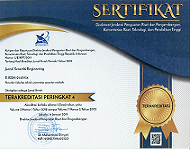Pengaruh Luas Permukaan Material Fotokatalis Cu-TiO2/ZnO dan Larutan HCl Terhadap Degradasi Methylene Blue dalam Photocatalytic Fuel Cell
Keywords:
Band Gap, Fotokatalis , Methylene Blue, limbah industriAbstract
Water pollution caused by industrial dye waste is a serious environmental issue due to the presence of synthetic dyes such as methylene blue (MB), which are difficult to degrade naturally. This study aims to evaluate the performance of Cu-doped TiO₂/ZnO photocatalysts in a Photocatalytic Fuel Cell (PFC) system for MB degradation. The photocatalyst was synthesized using the sol-gel method and characterized by SEM-EDX and UV-Vis DRS. Morphological analysis revealed spherical particles with signs of agglomeration, while EDX confirmed the presence of Cu, Ti, Zn, and O elements. Cu doping at 5% reduced the band gap from 3.18 eV to 2.29 eV, enhancing light absorption into the visible region. Performance tests in the PFC system showed that the optimal condition was achieved using a 7×3 cm glass plate with 15 mL of HCl, producing a maximum voltage of 0.66 V. The highest degradation efficiency of MB reached 58.10% after 120 minutes of irradiation. These results indicate that Cu-TiO₂/ZnO nanocomposites have strong potential as photocatalysts for colored wastewater treatment and simultaneous energy conversion in PFC systems.
References
[1] L. N. Ramadhika, S. Suryaningsih, and A. Aprilia, “Photoactivity Enhancement of TiO2Nanoparticle-decorated ZnO as a Photocatalyst in Methylene Blue Degradation,” J. Phys. Conf. Ser., vol. 2376, no. 1, 2022, doi: 10.1088/1742-6596/2376/1/012003.
[2] J. Singh, P. Yadav, A. K. Pal, and V. Mishra, “Water Pollutants: Origin and Status,” no. January, pp. 5–20, 2020, doi: 10.1007/978-981-15-0671-0_2.
[3] M. Pérez-González and S. A. Tomás, “Surface chemistry of TiO2-ZnO thin films doped with Ag. Its role on the photocatalytic degradation of methylene blue,” Catal. Today, vol. 360, no. July, pp. 129–137, 2021, doi: 10.1016/j.cattod.2019.08.009.
[4] M. Ikram et al., “Biodegradation of Azo Dye Methyl Red by Pseudomonas aeruginosa: Optimization of Process Conditions,” Int. J. Environ. Res. Public Health, vol. 19, no. 16, pp. 1–28, 2022, doi: 10.3390/ijerph19169962.
[5] A. A. Kadam, H. S. Lade, S. M. Patil, and S. P. Govindwar, “Low cost CaCl2 pretreatment of sugarcane bagasse for enhancement of textile dyes adsorption and subsequent biodegradation of adsorbed dyes under solid state fermentation,” Bioresour. Technol., vol. 132, pp. 276–284, 2013, doi: 10.1016/j.biortech.2013.01.059.
[6] K. Saini et al., “Effective utilization of discarded reverse osmosis post-carbon for adsorption of dyes from wastewater,” Environ. Res., vol. 231, no. P2, p. 116165, 2023, doi: 10.1016/j.envres.2023.116165.
[7] D. A. Daratika, M. A. Baqiya, and Darminto, “Synthesis of Zn1-xCuxO Nanoparticles by Coprecipitation and Their Structure and Electrical Property,” IOP Conf. Ser. Mater. Sci. Eng., vol. 196, no. 1, pp. 1–5, 2017, doi: 10.1088/1757-899X/196/1/012009.
[8] R. Jamee and R. Siddique, “Biodegradation of synthetic dyes of textile effluent by microorganisms: An environmentally and economically sustainable approach,” Eur. J. Microbiol. Immunol., vol. 9, no. 4, pp. 114–118, 2019, doi: 10.1556/1886.2019.00018.
[9] K. Sharma, S. Pandit, A. S. Mathuriya, P. K. Gupta, K. Pant, and D. A. Jadhav, “Microbial Electrochemical Treatment of Methyl Red Dye Degradation Using Co-Culture Method,” Water (Switzerland), vol. 15, no. 1, pp. 1–17, 2023, doi: 10.3390/w15010056.
[10] K. Zhao et al., “Efficient wastewater treatment and simultaneously electricity production using a photocatalytic fuel cell based on the radical chain reactions initiated by dual photoelectrodes,” J. Hazard. Mater., vol. 337, pp. 47–54, 2017, doi: 10.1016/j.jhazmat.2017.05.004.
[11] T. Marimuthu, N. Anandhan, R. Thangamuthu, and S. Surya, “Facile growth of ZnO nanowire arrays and nanoneedle arrays with flower structure on ZnO-TiO2seed layer for DSSC applications,” J. Alloys Compd., vol. 693, 2017, doi: 10.1016/j.jallcom.2016.09.260.
[12] P. Kumar, V. S. Kundu, S. Kumar, B. Saharan, V. Kumar, and N. Chauhan, “Hydrothermal Synthesis of Cu-ZnO-/TiO2-Based Engineered Nanomaterials for the Efficient Removal of Organic Pollutants and Bacteria from Water,” Bionanoscience, vol. 7, no. 4, 2017, doi: 10.1007/s12668-017-0452-9.
[13] X. Zhu et al., “Preparation and characterization of Cu-doped TiO2 nanomaterials with anatase/rutile/brookite triphasic structure and their photocatalytic activity,” J. Mater. Sci. Mater. Electron., vol. 32, no. 16, pp. 21511–21524, 2021, doi: 10.1007/s10854-021-06660-5.
[14] R. Zila and R. Zainul, “Phototransformator Humic Acid Using Cu Doping Tio2 Semiconductors Fototransformator Asam Humat Menggunakan Semikonduktor Tio2 Doping Cu,” Chem. J., vol. 8, no. 1, pp. 37–40, 2019, [Online]. Available: http://ejournal.unp.ac.id/index.php/kimia
[15] S. Priatmoko and S. Wahyuni, “Fotokatalis Ni-N-TiO 2 untuk Degradasi Metilen Biru,” Inov. Sains dan Kesehat., vol. 5, pp. 120–165, 2021.
[16] M. A. Bhatti et al., “ TiO 2 /ZnO Nanocomposite Material for Efficient Degradation of Methylene Blue ,” J. Nanosci. Nanotechnol., vol. 21, no. 4, pp. 2511–2519, 2021, doi: 10.1166/jnn.2021.19107.
[17] Q. Ayun, R. Ridho, and E. Malis, “Pengaruh Pelapisan Titanium Dioksida (Tio2) Pada Plat Kaca Terhadap Efektivitas Fotodegradasi Methyl Orange Menggunakan Metode Sodis (Solar Disinfection Water),” J. Cryst. Publ. Penelit. Kim. dan Ter., vol. 2, no. 1, pp. 37–50, 2020, doi: 10.36526/jc.v2i1.924.
[18] N. D. Andari and S. Wardhani, “Fotokatalis TiO2-Zeolit untuk Degradasi Metilen Biru,” Chem. Prog., vol. 7, no. 1, pp. 9–14, 2018.
[19] H. Chen, N. Chen, Y. Gao, and C. Feng, “Photocatalytic degradation of methylene blue by magnetically recoverable Fe3O4/Ag6Si2O7 under simulated visible light,” Powder Technol., vol. 326, 2018, doi: 10.1016/j.powtec.2017.12.029.
Downloads
Published
Issue
Section
License
Copyright (c) 2025 Tarishah Setyowati Putri, Sarah Dampang, Muhammad Fahmi Hakim, Fitri Yuliasari, David Kevin, Cicilia Putri Meylani (Author)

This work is licensed under a Creative Commons Attribution 4.0 International License.












